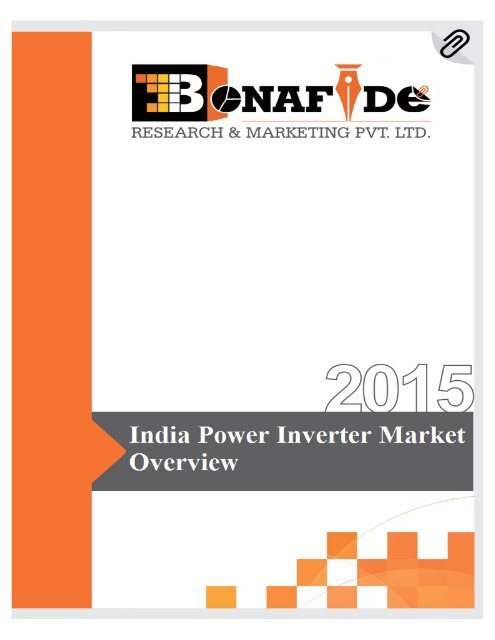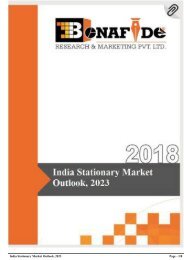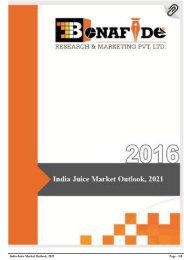Sample-India Power Inverter Market Overview
"Power or electricity is one of the most critical components of infrastructure affecting economic growth and well-being of every nation. The existence and development of adequate infrastructure is essential for sustained growth of the Indian economy. India’s power sector is one of the more ignored sectors in the Indian economy especially in the rural parts of the country remains without power, as does 6% of the urban population. This report is about the market size of the power inverters in India and how is it going to help the economy of the country by providing back up of the power whenever needed. This report reveals how government is supporting the power inverter market by computerization of schools and other development factors to achieve the grid parity in India. The report also reveals the trend in this industry is shifting to hybrid inverters and solar inverter in Indian power inverter market. The Power inverter market in India was growing at a CAGR of about 11.79 per cent during the period 2009—2014. The manufacturing ecosystem for these products is quite mature while technological requirements of Inverter manufacturing are greater than the manufacturing and design capabilities present in India currently. Some of the major players in the inverters market are Luminous, Su-kam, and Microtek. Steady demand from the home and SOHO segments is expected to buttress the growth of the inverter market. The unorganized segment has a large share of the inverter market, though its share has been declining lately due to enhanced consumer awareness. According to “India Power Inverter Market Overview”, the market for power inverters in India is expected to grow with a CAGR of 8.49% from 2015 to 2021. Central Inverters are the major market share acquirers of the inverter market. Micro-inverters are forecasted to increase its share technology wise. Residential segment is the new target of the inverter industry. The unorganized sector which was leading the market till 2012 is forecasted to shrink in the coming years. New entrants are also increasing and their revenue share is expected to grow over the forecasted period, owing to their expansion plans and widening of dealership networks. “India Power Inverter Market Overview” discusses the following aspects of water heaters in India:"
"Power or electricity is one of the most critical components of infrastructure affecting economic growth and well-being of every nation. The existence and development of adequate infrastructure is essential for sustained growth of the Indian economy. India’s power sector is one of the more ignored sectors in the Indian economy especially in the rural parts of the country remains without power, as does 6% of the urban population. This report is about the market size of the power inverters in India and how is it going to help the economy of the country by providing back up of the power whenever needed. This report reveals how government is supporting the power inverter market by computerization of schools and other development factors to achieve the grid parity in India. The report also reveals the trend in this industry is shifting to hybrid inverters and solar inverter in Indian power inverter market.
The Power inverter market in India was growing at a CAGR of about 11.79 per cent during the period 2009—2014. The manufacturing ecosystem for these products is quite mature while technological requirements of Inverter manufacturing are greater than the manufacturing and design capabilities present in India currently. Some of the major players in the inverters market are Luminous, Su-kam, and Microtek. Steady demand from the home and SOHO segments is expected to buttress the growth of the inverter market. The unorganized segment has a large share of the inverter market, though its share has been declining lately due to enhanced consumer awareness.
According to “India Power Inverter Market Overview”, the market for power inverters in India is expected to grow with a CAGR of 8.49% from 2015 to 2021. Central Inverters are the major market share acquirers of the inverter market. Micro-inverters are forecasted to increase its share technology wise. Residential segment is the new target of the inverter industry. The unorganized sector which was leading the market till 2012 is forecasted to shrink in the coming years. New entrants are also increasing and their revenue share is expected to grow over the forecasted period, owing to their expansion plans and widening of dealership networks. “India Power Inverter Market Overview” discusses the following aspects of water heaters in India:"
You also want an ePaper? Increase the reach of your titles
YUMPU automatically turns print PDFs into web optimized ePapers that Google loves.
Bonafide Research - A Brief Profile<br />
Bonafide Research & <strong>Market</strong>ing Pvt. Ltd. is a multi-disciplinary research and consulting<br />
company which provides all the information streams required to solve strategic, business and<br />
marketing problems. Bonafide is a “one-stop-shop” offering syndicated research reports,<br />
custom research solutions and marketing services for a variety of industry verticals. We focus<br />
on delivering high quality research services to business professionals, organizations and<br />
individuals, thus supporting in maximizing success from the current industry information.<br />
We bring first-hand information and prudent analysis of various industries, technologies,<br />
economic and non-economic market parameters, potential markets, and key competitors in the<br />
industry and give rational forecast for market trends to help clients identify prospective growth<br />
areas and gain competitive edge.<br />
Our strength lies in monitoring industry trends and data analysis using credible secondary data<br />
sources from Paid databases and Public domain.<br />
Team Profile<br />
Bonafide is a group of young professionals from varied backgrounds who have come together<br />
to create a team working in multiple areas across domains with an ever-increasing array of<br />
services. The team comes with a rich educational background from some of the world’s finest<br />
institutions, possessing post-graduate education in one or more of the following disciplines –<br />
Business Management, Engineering, Statistics, Economics, Mass Communication, English<br />
Honors., etc. Each member of the team is an expert of his/her own industry so they can deliver<br />
analysis, comments, opinions and advice on the latest market trends and conditions. Research<br />
analysts gather, identify and analyze the most reliable information and data to give an insight<br />
into the market which helps clients meeting their objectives. The team has handled several<br />
market research & consulting assignments with fortune 500 companies.<br />
<strong>India</strong> <strong>Power</strong> <strong>Inverter</strong> <strong>Market</strong> Outlook 2021 Page 2
TABLE OF CONTENTS<br />
1. Executive Summary<br />
2. Global <strong>Inverter</strong> <strong>Market</strong> Outlook<br />
2.1. <strong>Market</strong> Size By Value<br />
2.2. <strong>Market</strong> Size By Volume<br />
2.3. Pricing Analysis<br />
3. <strong>India</strong> Non Renewable <strong>Inverter</strong> <strong>Market</strong> Outlook<br />
3.1. <strong>Market</strong> Size By Value<br />
3.1.1. Overall <strong>Inverter</strong> <strong>Market</strong><br />
3.1.1.1. Total <strong>Inverter</strong> <strong>Market</strong><br />
3.1.1.2. Total Organized <strong>Inverter</strong> <strong>Market</strong><br />
3.1.1.3. Total Unorganized <strong>Inverter</strong> <strong>Market</strong><br />
3.1.2. Overall Residential <strong>Inverter</strong> <strong>Market</strong><br />
3.1.2.1. Total Residential <strong>Inverter</strong> <strong>Market</strong><br />
3.1.2.2. Organized-Unorganized <strong>Market</strong> Size in Residential <strong>Inverter</strong> <strong>Market</strong><br />
3.1.3. Overall Industrial <strong>Inverter</strong> <strong>Market</strong><br />
3.1.3.1. Total Industrial <strong>Inverter</strong> <strong>Market</strong><br />
3.1.3.2. Organized-Unorganized <strong>Market</strong> Size in Industrial <strong>Inverter</strong> <strong>Market</strong><br />
3.2. <strong>Market</strong> Size By Volume<br />
3.2.1. Overall <strong>Inverter</strong> <strong>Market</strong><br />
3.2.1.1. Total <strong>Inverter</strong> <strong>Market</strong><br />
3.2.1.2. Total Organized <strong>Inverter</strong> <strong>Market</strong><br />
3.2.1.3. Total Unorganized <strong>Inverter</strong> <strong>Market</strong><br />
3.2.2. Overall Residential <strong>Inverter</strong> <strong>Market</strong><br />
3.2.2.1. Total Residential <strong>Inverter</strong> <strong>Market</strong><br />
3.2.2.2. Organized-Unorganized <strong>Market</strong> Size in Residential <strong>Inverter</strong> <strong>Market</strong><br />
3.2.3. Overall Industrial <strong>Inverter</strong> <strong>Market</strong><br />
3.2.3.1. Total Industrial <strong>Inverter</strong> <strong>Market</strong><br />
3.2.3.2. Organized-Unorganized <strong>Market</strong> Size in Residential <strong>Inverter</strong> <strong>Market</strong><br />
3.3. <strong>Market</strong> Share<br />
3.3.1. By Region<br />
3.3.2. By Company<br />
3.3.3. By Technology<br />
<strong>India</strong> <strong>Power</strong> <strong>Inverter</strong> <strong>Market</strong> Outlook 2021 Page 3
3.3.4. By Division in Residential Segment in KVA<br />
4. Pricing Analysis of <strong>India</strong>n <strong>Inverter</strong> <strong>Market</strong><br />
5. Company Profiles<br />
5.1. Luminous<br />
5.2. Su Kam<br />
5.3. Microtek<br />
5.4. Genus<br />
5.5. Consol<br />
6. Disclaimer<br />
<strong>India</strong> <strong>Power</strong> <strong>Inverter</strong> <strong>Market</strong> Outlook 2021 Page 4
LIST OF FIGURES<br />
Figure 1: Global <strong>Inverter</strong> <strong>Market</strong> Size By Value 2009 - 2014 (USD Billion)<br />
Figure 2: Global <strong>Inverter</strong> <strong>Market</strong> Size By Value 2015F – 2021F (USD Billion)<br />
Figure 3: Global <strong>Inverter</strong> <strong>Market</strong> Size By Volume 2009 - 2014 (Million Units)<br />
Figure 4: Global <strong>Inverter</strong> <strong>Market</strong> Size By Volume 2015F - 2021 (Million Units)<br />
Figure 5: Global <strong>Inverter</strong> <strong>Market</strong> Average Selling Price 2009 - 2014 (USD)<br />
Figure 6: Global <strong>Inverter</strong> <strong>Market</strong> Average Selling Price 2015 - 2021 (USD)<br />
Figure 7: <strong>India</strong>n <strong>Inverter</strong> <strong>Market</strong> Size By Value 2009 - 2014 (USD Million)<br />
Figure 8: <strong>India</strong>n <strong>Inverter</strong> <strong>Market</strong> Size By Value 2015F – 2021F (USD Million)<br />
Figure 9: <strong>India</strong>n <strong>Inverter</strong> <strong>Market</strong> Size By Total Organized <strong>Inverter</strong> <strong>Market</strong> 2009 - 2014 (USD Million)<br />
Figure 10: <strong>India</strong>n <strong>Inverter</strong> <strong>Market</strong> Size By Total Organized <strong>Inverter</strong> <strong>Market</strong> 2015F – 2021 (USD Million)<br />
Figure 11: <strong>India</strong>n <strong>Inverter</strong> <strong>Market</strong> Size By Total Unorganized <strong>Inverter</strong> <strong>Market</strong> 2009 - 2014 (USD Million)<br />
Figure 12: <strong>India</strong>n <strong>Inverter</strong> <strong>Market</strong> Size By Total Unorganized <strong>Inverter</strong> <strong>Market</strong> 2015F – 2021F (USD<br />
Million)<br />
Figure 13: <strong>India</strong>n <strong>Inverter</strong> <strong>Market</strong> Size By Total Residential <strong>Inverter</strong> <strong>Market</strong> 2009 - 2014 (USD Million)<br />
Figure 14: <strong>India</strong>n <strong>Inverter</strong> <strong>Market</strong> Size By Total Residential <strong>Inverter</strong> <strong>Market</strong> 2015F – 2021F (USD Million)<br />
Figure 15: <strong>India</strong>n <strong>Inverter</strong> <strong>Market</strong> Size By Organized- Unorganized Residential <strong>Inverter</strong> <strong>Market</strong> 2009 -<br />
2014 (USD Million)<br />
Figure 16: <strong>India</strong>n <strong>Inverter</strong> <strong>Market</strong> Size By Organized- Unorganized Residential <strong>Inverter</strong> <strong>Market</strong> 2015F –<br />
2021F (USD Million)<br />
Figure 17: <strong>India</strong>n <strong>Inverter</strong> <strong>Market</strong> Size By Total Industrial <strong>Inverter</strong> <strong>Market</strong> 2009 - 2014 (USD Million)<br />
Figure 18: <strong>India</strong>n <strong>Inverter</strong> <strong>Market</strong> Size By Total Industrial <strong>Inverter</strong> <strong>Market</strong> 2015F – 2021F (USD Million)<br />
Figure 19: <strong>India</strong>n <strong>Inverter</strong> <strong>Market</strong> Size By Organized- Unorganized Industrial <strong>Inverter</strong> <strong>Market</strong> 2009 - 2014<br />
(USD Million)<br />
Figure 20: <strong>India</strong>n <strong>Inverter</strong> <strong>Market</strong> Size By Organized- Unorganized Industrial <strong>Inverter</strong> <strong>Market</strong> 2015F –<br />
2021F (USD Million)<br />
Figure 21: <strong>India</strong>n <strong>Inverter</strong> <strong>Market</strong> Size By Volume 2009 - 2014 (Million Units)<br />
Figure 22: <strong>India</strong>n <strong>Inverter</strong> <strong>Market</strong> Size By Volume 2015F – 2021F (Million Units)<br />
Figure 23: <strong>India</strong>n <strong>Inverter</strong> <strong>Market</strong> Size By Total Organized <strong>Inverter</strong> <strong>Market</strong> By Volume 2009 - 2014 (Million<br />
Units)<br />
Figure 24: <strong>India</strong>n <strong>Inverter</strong> <strong>Market</strong> Size By Total Organized <strong>Inverter</strong> <strong>Market</strong> By Volume 2015F – 2021F<br />
(Million Units)<br />
Figure 25: <strong>India</strong>n <strong>Inverter</strong> <strong>Market</strong> Size By Total Unorganized <strong>Inverter</strong> <strong>Market</strong> By Volume 2009 - 2014<br />
(Million Units)<br />
Figure 26: <strong>India</strong>n <strong>Inverter</strong> <strong>Market</strong> Size By Total Unorganized <strong>Inverter</strong> <strong>Market</strong> By Volume 2015F – 2021F<br />
(Million Units)<br />
Figure 27: <strong>India</strong>n <strong>Inverter</strong> <strong>Market</strong> Size By Total Residential <strong>Inverter</strong> <strong>Market</strong> By Volume 2009 - 2014<br />
(Million Units)<br />
Figure 28: <strong>India</strong>n <strong>Inverter</strong> <strong>Market</strong> Size By Total Residential <strong>Inverter</strong> <strong>Market</strong> By Volume 2015F – 2021F<br />
(Million Units)<br />
Figure 29: <strong>India</strong>n <strong>Inverter</strong> <strong>Market</strong> Size By Organized- Unorganized Residential <strong>Inverter</strong> <strong>Market</strong> 2009 -<br />
2014 (Million Units)<br />
Figure 30: <strong>India</strong>n <strong>Inverter</strong> <strong>Market</strong> Size By Organized- Unorganized Residential <strong>Inverter</strong> <strong>Market</strong> 2009 -<br />
2014 (USD Million)<br />
Figure 31: <strong>India</strong>n <strong>Inverter</strong> <strong>Market</strong> Size By Total Industrial <strong>Inverter</strong> <strong>Market</strong> By Volume 2009 - 2014 (Million<br />
Units)<br />
<strong>India</strong> <strong>Power</strong> <strong>Inverter</strong> <strong>Market</strong> Outlook 2021 Page 5
Figure 32: <strong>India</strong>n <strong>Inverter</strong> <strong>Market</strong> Size By Total Industrial <strong>Inverter</strong> <strong>Market</strong> By Volume 2015F – 2021F<br />
(Million Units)<br />
Figure 33: <strong>India</strong>n <strong>Inverter</strong> <strong>Market</strong> Size By Organized- Unorganized Industrial <strong>Inverter</strong> <strong>Market</strong> 2009 - 2014<br />
(Million Units)<br />
Figure 34: <strong>India</strong>n <strong>Inverter</strong> <strong>Market</strong> Size By Organized- Unorganized Industrial <strong>Inverter</strong> <strong>Market</strong> 2009 - 2014<br />
(USD Million)<br />
Figure 35: <strong>India</strong>n <strong>Inverter</strong> <strong>Market</strong> Share By Value 2009 & 2021F<br />
Figure 36: <strong>India</strong>n <strong>Inverter</strong> <strong>Market</strong> Share By Region By Value 2009 &2021F<br />
Figure 37: <strong>India</strong>n <strong>Inverter</strong> <strong>Market</strong> Share By Technology By Value 2009 & 2021F<br />
Figure 38: <strong>India</strong>n <strong>Inverter</strong> <strong>Market</strong> Share By Division in segment By Value 2014 & 2021F<br />
Figure 39: <strong>India</strong>n <strong>Inverter</strong> Pricing Analysis 2010-2021 (INR)<br />
Table 1: Key Facts of Luminous<br />
Table 2: Key Facts of Su Kam<br />
Table 3: Key Facts of Microtek<br />
Table 4: Key Facts of Genus<br />
Table 5: Key Facts of Consol<br />
LIST OF TABLES<br />
<strong>India</strong> <strong>Power</strong> <strong>Inverter</strong> <strong>Market</strong> Outlook 2021 Page 6
1. Executive Summary<br />
A power inverter, or inverter, is an electronic device or circuitry that changes direct current (DC)<br />
to alternating current (AC). The input voltage, output voltage and frequency, and<br />
overall power handling depend on the design of the specific device or circuitry. The inverter<br />
does not produce any power as the power is provided by the DC source.<br />
The global non renewable (power) inverter market is on an increasing trend with the ongoing<br />
gap in the power supply all over the world. <strong>Inverter</strong>s are now being used globally with new<br />
technologies and innovations being made. The global non renewable inverter market grew with<br />
a CAGR of around xxxx% within five years till 2014 and is expected to grow with a CAGR of<br />
close to xxxx% in the next six years till 2021. The global inverter market stands at USD xxxx<br />
Billion in 2014 which is expected to reach a market of USD xxxx Billion till 2021. The increasing<br />
use of inverters in the SOHO segment, the demand growth from the Asia Pacific region and the<br />
trend of people shifting from gensets to inverters will let the market increase in such a pace.<br />
While power inverters are establishing a foothold in the power industry, the gradual pace of<br />
economic recovery and restrained spending environment are stymieing inverter manufacturers‘<br />
efforts to expand. Prices are expected to drop as these products are being mass-produced. The<br />
price of an inverter was about xxxx USD in 2009 which is on a continuous decreasing trend<br />
since then.<br />
The <strong>India</strong>n <strong>Power</strong> <strong>Inverter</strong> <strong>Market</strong> stood at USD xxxx Million in 2014 and is on a continuously<br />
increasing trend till 2021. <strong>India</strong> does not have a grid that is efficient or sufficient enough for its<br />
people. Not only is there a lack of power compared to what is required, the power that we do<br />
receive is not efficient power and it thus incurs huge losses. <strong>Power</strong> quality and reliability has<br />
been (and remains) a concerning issue until today in <strong>India</strong>. From industrial and commercial<br />
sectors, the power requirement has increased, and this demand and supply gap is forcing<br />
<strong>India</strong> <strong>Power</strong> <strong>Inverter</strong> <strong>Market</strong> Outlook 2021 Page 7
establishments to opt for inverters and UPS systems to address this requirement. The market<br />
for inverters in <strong>India</strong> was characterized by a dominant presence of the unorganized sector.<br />
While the unorganized sector caters to the price-sensitive consumers, organized players mostly<br />
target the brand-conscious consumers. However, the low prices offered by the unorganized<br />
players are now compelling the organized players to reduce their prices to effectively maintain<br />
their competitive edge in the market.<br />
In <strong>India</strong>, the electric power projections depict a shortfall in power generation. The quality of<br />
power is also not as desired. Therefore, a suitable power conditioning system is needed to<br />
buffer the equipment from electric utility supply variations and fluctuations. <strong>Inverter</strong> is a device<br />
that converts direct current electricity to alternating current either for stand-alone systems or to<br />
supply power to an electricity grid. All processes which are continuous and not batch processes<br />
require continuous quality power supply. A reliable power supply is essential in both the<br />
residential and the industrial sector nowadays.<br />
Shifting focus to the inverter segment, previously, for hard-core backup power, people used<br />
gensets. Due to rising cost and storage challenges of diesel, people are starting to shift from<br />
gensets to power inverters. In some of the small office/home office (SOHO) and SME segments,<br />
diesel gensets are not completely being discarded but their usage is slowly being reduced; they<br />
are complementing the power inverters when they are completely discharged. The government<br />
is releasing schemes but, at the same time, due to lack of knowledge, the assemblers and<br />
integrators still do not know how to give you maximum benefit.<br />
The trend is moving towards hybrid inverters. These inverters use solar panels in combination<br />
with the main power to charge the battery, thus saving on the electricity cost. These inverters<br />
could help in integrating conventional energy sources with regular sources easily and are<br />
programmed to use conventional sources in a better way. Another emerging area is that of<br />
<strong>India</strong> <strong>Power</strong> <strong>Inverter</strong> <strong>Market</strong> Outlook 2021 Page 8
superior after-sales services. A widespread service centre network will help companies build<br />
trust and ensure recommendations from existing customers, thereby adding to their goodwill<br />
and brand value. Moreover, cross-selling platforms for low-voltage products via the diffused<br />
channels are expected to bring about a greater visibility amongst end users, thus leading to<br />
greater revenues.<br />
<strong>India</strong> <strong>Power</strong> <strong>Inverter</strong> <strong>Market</strong> Outlook 2021 Page 9
3. <strong>India</strong> Non Renewable <strong>Inverter</strong> <strong>Market</strong> Outlook<br />
<strong>Power</strong> or electricity is one of the most critical components of infrastructure affecting economic<br />
growth and well-being of nations. The existence and development of adequate infrastructure is<br />
essential for sustained growth of the <strong>India</strong>n economy. <strong>India</strong>‘s power sector is one of the more<br />
ignored sectors in the <strong>India</strong>n economy especially in the rural parts of the country remains<br />
without power, as does 6% of the urban population.<br />
The inverter and UPS market in <strong>India</strong> was estimated to be worth US$ xxxx million in 2012 out of<br />
which the inverter market stands at US$ xxxx million and grow at about xxxx per cent during the<br />
period 2010—2015. The manufacturing ecosystem for these products is quite mature while<br />
technological requirements of UPS manufacturing are greater than the manufacturing and<br />
design capabilities present in <strong>India</strong> currently. Some of the major players in the inverters market<br />
are Luminous, Su-kam, and Microtek. Steady demand from the home and SOHO segments is<br />
expected to buttress the growth of the inverter market. The unorganized segment has a large<br />
share of the inverter market, though its share has been declining lately due to enhanced<br />
consumer awareness.<br />
Unorganized players source their products in knocked-down units from East Asia, which do not<br />
compare favorably with locally produced products in their quality and reliability. However, their<br />
input costs have increased on account of levying of duties on the import of lead and lead<br />
products. Also, organized players have strengthened their distribution networks, thus posing a<br />
formidable challenge to the unorganized players. Due to frequent power failures, inverters,<br />
specifically sub-5kVA inverters, are increasingly being used in applications like emergency<br />
lighting, elevator backup systems and other non-critical systems. The demand for inverters is<br />
seasonal, peaking during the summer due to frequent power outages. This situation, especially<br />
in the southern states, has contributed to the sharp rise in demand. The enforcement of<br />
<strong>India</strong> <strong>Power</strong> <strong>Inverter</strong> <strong>Market</strong> Outlook 2021 Page 10
pollution control norms is likely to support the substitution of generator sets with inverters of<br />
similar capacity. The market is also witnessing the entry of consumer durables players.<br />
The <strong>India</strong>n power inverter market was worth about Rs xxxx billion in 2010-11, in terms of<br />
revenue. The market is projected to grow at a double-digit rate during the next three to four<br />
years. This is likely to be the result of a steady demand from the domestic, small-office homeoffice,<br />
small and medium enterprises (SMEs), and commercial, industrial and other sectors.<br />
The domestic manufacturing of inverters possesses medium value addition; all the electronics<br />
components are mostly imported. Various companies present in the <strong>India</strong>n industry leverage<br />
their local competencies and global supply to serve the domestic market. <strong>India</strong> is more or less<br />
self-sufficient in the manufacturing of inverters. The most valuable component inside of an<br />
inverter is the transformer and <strong>India</strong> possesses considerable capabilities for their manufacture.<br />
Such capabilities could enable the country act as an export hub to countries such as<br />
Philippines, Vietnam, Sri Lanka etc.<br />
One of the major buyers of inverters today is the government of <strong>India</strong>. Of late, our government<br />
has not floated any major tenders, as a result of which sale of inverters has taken a hit. While<br />
government schemes such as computerization of schools have boosted the industry in the past,<br />
not many new funds have been allocated to schools in the recent times. This has, in turn,<br />
affected the number of orders, thereby leading to a decline in sales. On the brighter side, the<br />
government‘s initiative of computerization of its various departments is benefitting the industry,<br />
currently keeping the industry afloat.<br />
<strong>India</strong> <strong>Power</strong> <strong>Inverter</strong> <strong>Market</strong> Outlook 2021 Page 11
3.1. <strong>Market</strong> Size By Value<br />
3.1.2. Overall Residential <strong>Inverter</strong> <strong>Market</strong><br />
3.1.2.2. Organized-Unorganized <strong>Market</strong> Size in Residential <strong>Inverter</strong> <strong>Market</strong><br />
The unorganized sector in the <strong>Inverter</strong> market mainly catered the residential segment in 2009.<br />
The residential segment used inverter with capacity less than 5 KVA.<br />
Fig : 15 <strong>India</strong>n <strong>Inverter</strong> <strong>Market</strong> Size By Organized- Unorganized Residential <strong>Inverter</strong> <strong>Market</strong><br />
2009 - 2014 (USD Million)<br />
Source: Bonafide Research<br />
Till 2011, the unorganized market ruled in the whole <strong>Inverter</strong> market by segmenting majorly in<br />
the residential segment. The organized sector generated revenue of USD xxxx Million where as<br />
the unorganized sector generated a market of USD xxxx Million. The gap narrowed with the<br />
entry of the organized players into the market. The people of <strong>India</strong> are always price sensitive<br />
because of which the unorganized segment were a hit back then. But now with the active<br />
participation of the organized players in the residential segment by good distribution channel,<br />
new innovation in technologies and lowering in the prices of the inverters the organized sector<br />
are back in the game.<br />
2009 2010 2011 2012 2013 2014<br />
Organized<br />
Unorganized<br />
In 2014, the market size acquired by the unorganized market went down to reach USD xxxx<br />
Million whereas the market acquired by the organized market raise to reach USD xxxx Million.<br />
<strong>India</strong> <strong>Power</strong> <strong>Inverter</strong> <strong>Market</strong> Outlook 2021 Page 12
The unorganized market in the residential sector is forecasted to shrink as compared to the<br />
organized sector. The people are becoming more aware about the brands and the choices that<br />
are available the organized market has taken a huge jump. Luminous, Microtek and Su-kam<br />
cover about xxxx% of the organized market in the <strong>India</strong>n inverter market.<br />
Fig : 16 <strong>India</strong>n <strong>Inverter</strong> <strong>Market</strong> Size By Organized- Unorganized Residential <strong>Inverter</strong> <strong>Market</strong><br />
2015F – 2021F (USD Million)<br />
2015 2016 2017 2018 2019 2020 2021<br />
Organized<br />
Unorganized<br />
Source: Bonafide Research<br />
The residential segment of the organized segment is those inverters with the capacity of less<br />
than xxxx KVA. The organized sector is expected to lead through brand building, channel<br />
expansion, building service infrastructure and of course, lowering the price gap between<br />
organized and unorganized players by product innovation.<br />
The organized sector is expected to have a market of USD xxxx Million by 2018 whereas the<br />
unorganized sector is expected to have a market size of USD xxxx Million in the residential<br />
segment. By 2021, the organized market is expected to acquire a market of USD xxxx Million in<br />
the residential sector alone whereas that of unorganized is expected to decrease to reach USD<br />
xxxx Million in the same year.<br />
<strong>India</strong> <strong>Power</strong> <strong>Inverter</strong> <strong>Market</strong> Outlook 2021 Page 13
3.3. <strong>Market</strong> Share<br />
3.3.1. By Region<br />
The grid collapse may have inconvenienced many and caused losses too few industries, but<br />
one segment is not complaining, manufacturers of power backup products such<br />
as generator sets, inverters and batteries across north <strong>India</strong> are seeing a demand surge as a<br />
result of the twin power outages.<br />
Fig : 35 <strong>India</strong>n <strong>Inverter</strong> <strong>Market</strong> Share By Region By Value 2009 & 2021F<br />
2014 2021<br />
North<br />
South<br />
East<br />
West<br />
Source: Bonafide Research<br />
There has been an instant rise in sales queries for gensets. From five-six queries a day, it is 20-<br />
25 now. The highest demand from residential areas has been for xxxx kva genset, priced Rs<br />
xxxx lakh, which can run up to one air conditioner, while commercial units enquire mostly for xxx<br />
kva genset, which costs around Rs xxxx lakh.<br />
As per a report of the Associated Chambers of Commerce and Industry of <strong>India</strong> (Assocham),<br />
the demand for inverters, genset and battery has risen by 70 per cent in Delhi-NCR this<br />
summer. There has been an almost xxx per cent increase in the sale of inverters this month.<br />
Not only households, even small establishments and shops have started going for UPS for<br />
having minimum lighting and fans on in their shops for the convenience of the customers. These<br />
<strong>India</strong> <strong>Power</strong> <strong>Inverter</strong> <strong>Market</strong> Outlook 2021 Page 14
gadgets not only provide people relief from the sweltering heat, but also come to their aid in<br />
running their business.<br />
Demand for inverters and generators this summer is likely to grow by about 30 per cent in the<br />
national capital region (NCR), which may face power shortage of up to 10 hours, industry body<br />
Assocham said on Monday. The demand for inverters, their batteries and generators will rise to<br />
the extent of xxxx per cent as NCR is unlikely to be supplied power supplies either from<br />
neighboring region or else from far off power producing sources.<br />
Manufacturing hub of the <strong>India</strong>n power backup industry is concentrated in North <strong>India</strong>,<br />
particularly Himachal Pradesh, and Kolkata. <strong>Power</strong> deficit in the southern region of the country<br />
has triggered the demand for power backup in these regions. Tamil Nadu, Karnataka and<br />
Kerala generate the highest share of the overall demand for power backup in the country.<br />
Shortage in coal and gas, the primary raw materials for power generation, further aggravates<br />
the shortage in power supply. With time, consumers have emerged to be less tolerant about the<br />
duration of power cuts, thus providing tremendous growth prospects, which players can<br />
capitalize upon.<br />
<strong>India</strong> <strong>Power</strong> <strong>Inverter</strong> <strong>Market</strong> Outlook 2021 Page 15
5. Company Profiles<br />
5.1. Luminous<br />
Luminous, a leading player in the estimated Rs. xxx <strong>India</strong>n inverter and power storage market,<br />
which is growing at over xxxx per cent annually, generated revenues of around Rs. Xxxx crore<br />
in 2010-11. It has a wide distribution network of network of xxxx channel partners with xxxx<br />
distributors serving over xxxx retail outlets. The total net debt of the company was Rs. Xxx<br />
crore as of March 31 2011.<br />
Luminous' Chairman, who will continue to hold xxxx per cent in the firm, plan to be closely<br />
associated with the company. Luminous, which employs xxx, will provide Schneider a broad<br />
customer base with xxxx million existing inverter users and also access to clients in sectors<br />
such as government and telecom. With over xxxx employees, seven manufacturing units, xxxx<br />
sales offices and more than xxxx channel partners; Luminous has a dominating position in the<br />
UPS, inverter market. Founded in 1988, today it has a differentiated portfolio of solutions for<br />
packaged power, diversified generation, electrical control & safety and energy optimization. It<br />
has been awarded with the ‗Global Superbrands‘ status for the year 2011-12, ISO 50001:2011<br />
certification and MNRE: CRISIL recognition.<br />
France‘s Schneider Electric SA bought xxxx % of privately held <strong>India</strong>n inverter<br />
manufacturer Luminous <strong>Power</strong> Technologies Pvt. Ltd for around € xxx million to boost revenue<br />
and market share in Asia‘s third largest economy. Schneider‘s eighth acquisition in <strong>India</strong> since<br />
2000 is likely to raise its sales in the country to more than Rs xxxx crore, tripling 2009 revenue,<br />
said Olivier Blum, managing director, Schneider Electric <strong>India</strong>.<br />
Manufacturing facilities:<br />
<strong>India</strong> <strong>Power</strong> <strong>Inverter</strong> <strong>Market</strong> Outlook 2021 Page 16
Luminous has 7 manufacturing facilities in <strong>India</strong>. It has the <strong>India</strong>'s largest home UPS and line<br />
interactive/ online UPS manufacturing facilities. It also is amongst the world's most focused<br />
manufacturers of Deep Cycle Flooded Batteries. Relentless focus on process control and<br />
product testing leads them towards swift improvement in life cycle.<br />
Technology Used:<br />
Their Battery R&D team is headed by an American CTO with over xxx years of experience in<br />
battery industry. They have the Best Deep Cycle Flooded Lead Acid Battery Technology<br />
developed along with Eagle-Picher Inc, USA, a global leader in long life battery technology.<br />
Technology for manufacturing Lead Calcium Long Life Deep Cycle VRLA Batteries for UPS &<br />
EPS applications, developed together with Eagle Picher Inc, USA.<br />
Research and Development:<br />
They have advanced R&D facility with 15 Engineers and 27 technicians, lead by a dynamic<br />
personality who holds a Ph.D. and has 21+ years of experience in the field of power electronics.<br />
Luminous uses highly sophisticated equipments like ―Agilent‖ which makes DSO (Digital storage<br />
oscilloscope), ―Yokogawa‖ powered analyzers, ―Chroma‖ AC-DC Electronic Load,<br />
Environmental Temperature chamber, Digital data loggers, Precision multi meters, Digital<br />
venires, Screw gauges etc. They also have the biggest In House Battery Lab facilities for<br />
Battery charging& discharging algorithms validation & life cycle testing of all kind of batteries.<br />
They have an In house Design Team: PCB Design (using latest design software with simulation)<br />
headed by design engineer with an experience of 10 years. They provide DSP Lab facilities:<br />
Software development centre with four engineers headed by an engineer with 15+ year<br />
experience<br />
They have a special Mechanical Design Team who develops all aesthetic designs using Auto-<br />
CAD & Solid works software, tool designing for enclosures including plastic molding.<br />
<strong>India</strong> <strong>Power</strong> <strong>Inverter</strong> <strong>Market</strong> Outlook 2021 Page 17
Independent validation Team of 7-engineers & technicians who continuously engage in<br />
validating comparison with competitors<br />
Presence in <strong>India</strong>:<br />
Luminous has a strong dealer distributor network all over <strong>India</strong> which takes care of the<br />
customers whenever needed. They have developed service centers in xxxx cities and service<br />
presence in xxxx cities. They provide door step service facility for consumers with xxx Hours<br />
response time. In the northern region Luminous has about xxxx Distributors and xxxx Dealers<br />
whereas in the southern area it has xxxx Distributors and xxxx Dealers. In the eastern region<br />
the dealer distributor network is a bit low with xxxx Distributors and xxxx Dealers and the least<br />
distribution channel is provided in the xxxx region with xxxx distributors and xxxx dealers.<br />
Now, Luminous is gearing up to launch solar inverters targeted at businesses, including gas<br />
stations, petrol pumps etc. In 2012, the company provided hybrid power backup solutions to<br />
xxxx odd cell towers of public sector telecom major BSNL. Since they have the expertise and<br />
wherewithal to service telecom companies, they would be bidding for such projects in future.<br />
Luminous is amongst the top two power backup solutions companies in <strong>India</strong>. Uttar Pradesh is<br />
the biggest market for Luminous with over xxxx channel partners. The company is now<br />
gradually entering the electrical products market with the launch of fans, switch boards, cables<br />
etc. Their strategy is to have a complete value chain in the power backup and electrical space.<br />
<strong>India</strong> <strong>Power</strong> <strong>Inverter</strong> <strong>Market</strong> Outlook 2021 Page 18
Table-2: Key Facts of Luminous<br />
Head Office<br />
C 8 & C 9 Community Center, Behind Janak Cinema<br />
Complex, Janakpuri, New Delhi-110058<br />
Phone +91-11-40778222/221<br />
Web Address<br />
www.luminousindia.com<br />
Revenue/ Turnover Rs xxxx million(2011 - 2012)<br />
Employees<br />
xxxx<br />
Manufacturing Facilities<br />
Seven in Himachal Pradesh and Maharashtra<br />
Manufactures<br />
UPS systems, inverters, batteries, electrical products,<br />
solar lanterns, solar lamp systems and charge controllers<br />
Year of Establishment 1988<br />
Key People<br />
Mr. Rakesh Malhotra (Chairman)<br />
Mr. Vipul Sabharwal (Managing Director)<br />
Mr. Manish Pant (Director)<br />
Sectors it caters to<br />
Home, commercial and solar<br />
Source: Company Annual Report<br />
<strong>India</strong> <strong>Power</strong> <strong>Inverter</strong> <strong>Market</strong> Outlook 2021 Page 19
6. Disclaimer<br />
The contents of this report are based on information generally available to the public from<br />
sources believed to be reliable. No representation is made that it is timely, accurate or<br />
complete. Bonafide Research has taken due care and caution in compilation of data as this has<br />
been obtained from various sources including which it considers reliable and first hand.<br />
However, Bonafide Research does not guarantee the accuracy, adequacy or completeness of<br />
any information and it is not responsible for any errors or omissions or for the results obtained<br />
from the use of such information and especially states that it has no financial liability whatsoever<br />
to the subscribers / users of this report. The information herein, together with all estimates and<br />
forecasts, can change without notice.<br />
All the figures provided in this document are indicative of relative market size and are strictly for<br />
client‘s internal consumption. Usage of the same for purpose other than internal will require prior<br />
approval of Bonafide Research.<br />
<strong>India</strong> <strong>Power</strong> <strong>Inverter</strong> <strong>Market</strong> Outlook 2021 Page 20


















